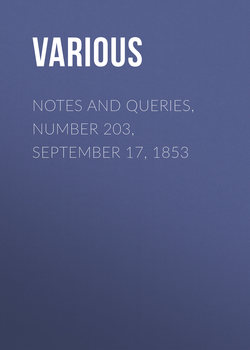Читать книгу Notes and Queries, Number 203, September 17, 1853 - Various - Страница 2
Notes
MR. PEPYS AND EAST LONDON TOPOGRAPHY, ETC
ОглавлениеIn "N. & Q." (Vol. i., p. 141.) there appeared an article upon the Isle of Dogs, &c., which spoke of the neglected topography of the east of London, and requested information on one or two points. Having felt much interested in this matter, I have endeavoured to obtain information by personal investigation, and send you the following from among a mass of Notes:—
1. Isle of Dogs. In a map drawn up in 1588 by Robert Adams, engraved in 1738, this name is applied to an islet in the river Thames, still in part existing, at the south-west corner of the peninsula. From this spot the name appears to have extended to the entire marsh.
2. Dick Shore, Limehouse. This is now called Duke Shore, Fore Street. In Gascoyne's Map of Stepney, 1703, it is called Dick Shoar. Since that time Dick has become a Duke. Mr. Pepys would find boats there now if he visited the spot.
3. Mr. Pepys, in his Diary of Mar. 23, 1660, speaks of "the great breach," near Limehouse. The spot now forming the entrance to the City Canal or South Dock of the West India Dock Company was called "the breach," when the canal was formed.
4. July 31, 1665. Mr. Pepys speaks of the Ferry in the Isle of Dogs. This ferry is named as a horse-ferry by Norden in the Britanniæ Speculum, 1592 (MS.). The ferry is still used, but only seldom as a horse-ferry.
5. Oct. 9, 1661. Mr. P. mentions Captain Marshe's, at Limehouse, close by the lime-house. There is still standing there a large old brick house, which may be the same; and the lime-kiln yet exists, for, as Norden says, "ther is a kiln contynually used."
6. Sept. 22, 1665. Mr. P. speaks of a discovery made "in digging the late docke." This discovery consisted of nut trees, nuts, yew, ivy, &c., twelve feet below the surface. Johnson no doubt told him the truth. The same discovery was made in 1789, in digging the Brunswick Dock, also at Blackwall, and elsewhere in the neighbourhood.
This very week (Aug. 25, 1853) I procured specimens of several kinds of wood, with land and freshwater shells, from as great a depth in an excavation at the West India Docks; the wood from a bed of peat, the shells from a bed of clay resting upon it. There exists an ancient house at the dock which Mr. P. visited, and which is probably the same.
Other illustrations of the Diary from this quarter might be adduced; let these, however, suffice as a specimen.
It may probably be new to most of your readers, as it is to me, that an ancient house in Blackwall (opposite the Artichoke Tavern) is said to have been the residence of Sebastian Cabot at one time, and at another that of Sir Walter Raleigh. Whether the tradition be true or not, the house is very curious, and worth a visit, if not worthy of being sketched and engraved to preserve its memory. Perhaps the photograph in this case could be applied.
It is not impossible that Sir John de Pulteney or Poultney, to whom the manor of Poplar was granted in the 24th of Edward III., resided on this spot. My reasons for thinking it are—this fact, which connects him with the neighbourhood; and the inference from two other facts, viz. that the house in which Sir John resided in town was called Cold Harbour, and that Cold Harbour is here also to be found. Sir John Pulteney is thus connected with both the places known by this name.
I would give my name in verification, but you have it, as you should have the names and addresses of all your correspondents.
B. H. C.
Poplar.
